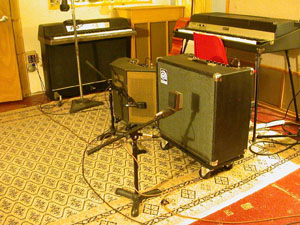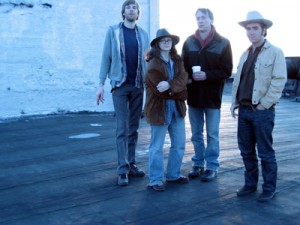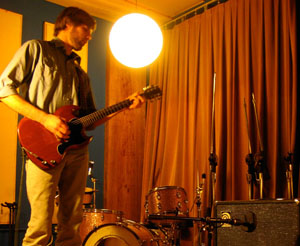Big Grungy Guitar Sounds in Brooklyn, With Josh Clark & Rope
Rope, an up-and-coming psychedelic roots-rock band from Brooklyn, began as producer/engineer Josh Clark’s studio side project. The co-owner of Seaside Lounge Recording in Park Slope, Clark began recording some of his own songs in between sessions with bands like Beirut, The National, Dark Horse & the Carousels, Antietam and Hopewell. Clark’s a busy producer/engineer, but his own project was always simmering on the back burner.
The music developed under the name, Rope, over a couple years of these intermittent sessions, as Clark’s vision and aptitude for the project sharpened. Woven of interplaying guitars, restless vocals and psychedelic jams, Rope’s debut EP has a feedback-drenched, rock band sound made up of performances largely improvised by Clark, himself. Since its release, he’s assembled a real-live-band, with members of Federale, so Rope has now emerged from the studio — check them out at Union Hall in Brooklyn on January 8, 2010.
Here, Clark reveals the guitar recording techniques he used to create Rope’s big classic rock sounds on his own, at Seaside Lounge. Read on!
What is Rope’s signature guitar sound? And how’d you capture it on the record?
It’s my Guild M-80 through an Ampeg VT-40 with a Coles 4038 ribbon mic a foot from the speaker, and generally double tracked and put in stereo. Over the course of making the record, our Coles had to get re-ribboned, and so I switched to a Beyerdynamic m 320, which is another great ribbon mic. I love ribbons, they’re so silky and they’re not terribly open, but they’re perfect to use when you’re double-tracking guitars.
So, I’ll record one guitar track straight through, and I’ll pan that hard-left. Then I’ll record another guitar straight through and pan it hard-right. That’s the big guitar sound. It’s so easy to do — two of the exact same tones, panned hard left and right, and your guitars just sound huge.
So, you set up the mics one foot from the speaker, how are they placed exactly?
I’m not super-exacting about mic placement. I know right away if the instrument I’m recording doesn’t sound like it does in the room. We have all these great-sounding old amps, so it’s easy. I just put the mic up. I aim it straight at the cone, but I never over-think it.
Did you use the same miking and recording technique for guitars on all the songs?
No. One of the songs, “Get It Now,” I entirely recorded and mixed in two days. The whole recording consisted of two microphones. In the intro, you’ll hear a bunch of room sound. It’s two mics—a Coles 4038 and a Neumann KM 86 in Mid-Side setup, like three feet out from the drum kit. I recorded drums, and then, I had my amp in the room, so I swung them around and recorded the two guitar tracks. The mics were about five feet out from the amp, and I used one as my room mic, and the other pointing at the amp as the “close mic.” I love the way that song came out. It’s the kind of song I’ve always wanted to write — a two-and-a-half-minute, five-chord song based on a melody. Like a Tom Petty song or something.

Pictured at Seaside is (left) a 1950s-era Gibson stereo amp miked with a 409—“used for some in-your-face leads”--along with Clark’s VT40, miked with a Beyerdynamic m 320 ribbon mic, which Clark says was “a great cardioid alternative to our Coles 4038.”
I also hear a lot of Neil Young in you, on both guitars and vocals.
Yeah, well Neil Young is just a really emotive player, and that’s the way I feel when I’m writing my music. I just want it all to come through the guitar. As long as enough comes through on the vocals, I’m happy.
As for other differences in how I recorded guitars, the two main guitar tracks on the song, “I Gotta Have All The Love” were recorded using different amps. That’s the Guild M-80 and the panned-left track was amped by a Fender Champ, the panned-right track was a Fender Pro Reverb. The VT-40 has this super-compressed, not terribly dynamic sound to it that I didn’t want on that song, cuz it’s just more of a classic Creedence Clearwater-like rock-and-roll song. So, I switched the amp on both sides and miked both amps with the Beyerdynamic m 320.
As far as preamps, I’m consistent with the API 212s for recording guitars. They’re also really silky and they compliment the ribbons perfectly for distorted guitar. I don’t use compression or EQ in tracking, I like the sound to hit the tape on our 16-track 3M M56 tape machine as naturally as possible.
So, you have your main guitar sound, and then all these other layers of effected guitar tracks and feedback, etc. What’s the source of your other repeating guitar sounds?
Well besides the Ampeg VT-40 and Coles ribbon mic, my other secret weapon is the Fulltone Octafuzz. I used a Rat here and there, but on any of the wacked-out crazy leads, like at the end of “You Still Suck,” that’s Octafuzz.
After I put down the two guitars, left and right, I recorded leads in the control room with the music blaring out of the speakers. I monitor pretty loudly in there, I’ll stand right up in front of the monitors so I feel like I’m standing in front of an amplifier. Sometimes to get feedback, I’d need to record the lead in the live room, but my guitar has tons of sustain so it’s never a problem.
Some of the instrumental jams feel pretty psychedelic—did you bring in any other effects, or just feedback, on those?
In general, I don’t do anything with effects, I really like making different sounds out of what I’ve got. I’m big on feedback. On the VT-40, if you turn up the reverb and turn up the volume, you can do insane things, just with the playing, depending on where you pick the notes.
For instance, on the song, “Montagne,” I recorded guitars in the live room because I needed a ton of feedback. I turned the amp up really loud. Throughout the song, there are two main guitar tracks that are playing the riff, then two that are swimming all around as the harmonies and leads. There are all these really fast hammer-ons that I’m not terribly efficient on, and they’re all over the neck. It took a long time to get those in one take because I’d be like halfway through a perfect take and I’d move 1/2-inch and the feedback would totally change. I’d be sustaining notes over 8 bars and if it died, I’d have to start all over again.
Listen to Rope’s “Montagne,” here!

Josh Clark (left) is a producer and touring guitar player with indie-rock band, Antietam, with Tara Key, Tim Harris and Josh Madell. Photo by: Tara Key
Is there a song you feel best captures what you’re trying to do musically, if there’s a sort of concept behind what you’re doing?
The song called “Not The Only One” is the epitome of what I do with guitar. When I did the demo, it was the first time I learned the power of three guitar tracks. And, they’re all playing the same thing, but differently in each part. So, there’s all this movement.
It’s three of the same exact sounding guitars, with same amp, miked exactly the same way, recorded dry without any reverb. It’s just the playing that’s different. It’s the best guitar playing I’ve ever done, and it’s all improvised.
At the end, it’s like two minutes of me basically just hitting the A string, but when there’s three of them, it sounds like there’s all this stuff going on. I could never repeat it, I’m just like bashing on the strings. If I were to solo one guitar track it would sound really silly.
So, since putting out the EP, you’ve assembled a band. What was that like, and when can we see you play?
Turning this project into a live thing was really tough, but in the end just came down to finding the right people to play with. I’m really lucky to have some talented friends who are open to my ideas, which I’ve realized sound perfectly normal to me, but don’t always play out that way.
Now, I have a full band that rules! It’s Jesse Cohen (bass) and John Stendrini (guitar) from Federale, Zach Cale (guitar) and Aaron Gimmell on drums. We’re playing Union Hall on January 8 with two bands I love, Soft Black and Precinct.
Rope will be releasing a two-song 7” on All Hands Electric in 2010.







